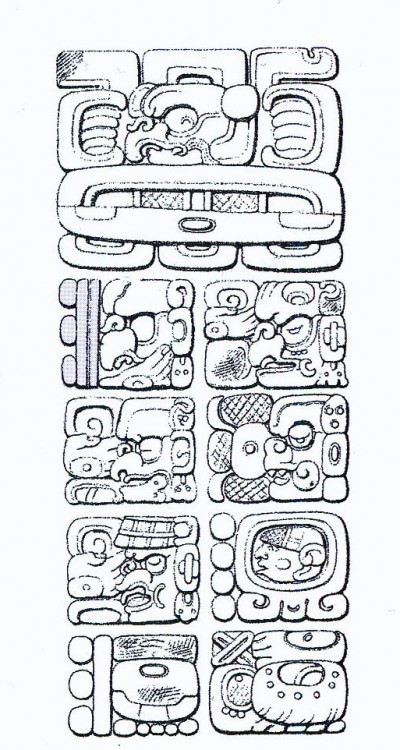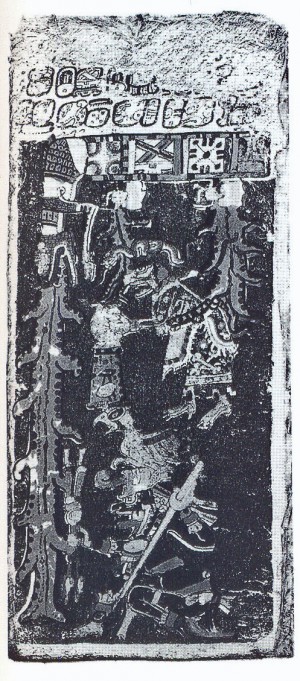Maya Myth: Will the World End in 2012?
3 Ιανουαρίου 2010

This painted vase shows the cigar-smoking lord of the Underworld, God L, as he presides over an important ritual at the dawn of the last creation in 31 14 BC. The black background probably alludes to a primeval world before the arrival of light.
Again there comes a humiliation, destruction, and demolition…. There came a rain of resin from the sky. There came the one named Gouger of Faces: he gouged out their eyeballs. There came Sudden Bloodletter: he snapped off their heads.
THE POPOL VUH, 16TH CENTURY
COME DECEMBER 2012, the current race of humans is due to be wiped from the face of the earth in a fearful cataclysm, which, to judge from the last destruction by fire, flood and a plague of demons, will come in an unexpected and terrible form. At least, that is what we can expect to be told as we enter the ‘final countdown’ of the ancient Maya calendar. Give or take a day or so, the 23rd of that fateful month will mark the end of 13 Bak’tuns of the Long Count cycle, completing a journey of 1,872,000 days that began with the last such event in 3114 BC. But what do we actually know about this elaborate system and what did the Maya think was going to happen in 2012?
The Maya, the most sophisticated and literate of Central America’s ancient civilizations, believed in a cyclical universe, one that had experienced recurring creations and annihilations. The best source on these ideas is the Popol Vuh, or ‘Book of Council’, a mythological epic produced by the Quiche Maya of highland Guatemala, probably in the late 16th century (though perhaps based on an original written in hieroglyphs). It begins with the parting of sky and earth, which allows the first light into the world. It then describes how the Creator Gods try to populate it with humankind. Their first attempt produces the animals of the earth, but since they cannot speak and praise their makers they are banished to the forest as failures. In the second, people are formed from clay, but they jabber insensibly and their bodies start to crumble. The gods break them up in disgust. For the third creation humans are formed from wood, but they have no souls and forget their creators. To destroy them the gods not only produce the aforementioned flood, fire and demons, they even make their cooking utensils rise up against them, crushing their faces with stones. Finally, the gods try maize dough as the stuff of life and the people of today came into being.

A monolith at the city of Quirigua called Stela C contains the best description of the creation events of 3114 BC. One side records the completion of 13 Bak'tuns (detail). Note the number 13 (highlighted), composed of three dots and two bars, with each dot representing one and the bar representing five.

This scene from the Dresden Codex, a late hieroglyphic book, appears to show the destruction of the earth by flood. A sky caiman and an aged goddess pour water on to the deity God L.
There is much in the greater Popol Vuh myth that we can recognize in the art of Maya civilization’s highpoint, the Classic period (AD 250-909), but it is clear that it contains ideas of even deeper antiquity. If the Classic Maya believed in a cyclical universe then its timing, both genesis and armageddon, should be encoded in their Long Count calendar. No one knows exactly where or when this system was invented, but the earliest contemporary date we have falls only in 32 BC. Long Count dates are written in a five-place notation, mostly working in a base of 20 unlike our own base 10. The highest value was normally the Bak’tun – a unit of 144,000 days – but we know that there were 19 higher ones, rarely expressed, all set with the coefficient 13. The full Long Count was thus of unimaginable scale, encompassing many trillions of years (far longer than our own universe has existed).
Advances in deciphering the Maya script give some insights into the events of the last 13 Bak’tun date in 3114 BC. These focus not on destruction but creation: there is an Ordering’ of gods, the forming of a central ‘hearth’ and a ‘planting of stones’. Since this was not a true year zero, the inscriptions also tell of mythic episodes long before 3114 BC. Similarly, the Maya calculated dates well into the future, with one royal anniversary projected forward to AD 4772. There can thus be no sense in which 2012 represents the ‘end of time’.
Only one inscription, found at the site of Tortuguero, prophetically describes the ending of 13 Bak’tuns in 2012. Sadly, it is damaged and only partially legible. It does refer to b’olon okte’, the name of a well-known Maya god, here prefixed by the term yem ‘descending’.This is rather reminiscent of the image of the Diving God that becomes so popular in Maya art of the Post classic era (AD 909-1697).
As we know, the Long Count did not survive to see more than a fraction of its vast vision unfold. The last proper date was carved at Tonina, Mexico, in 909. The previous century had seen a social, ecological and demographic crisis sweep the region, bringing Classic civilization to an end (see pp. 282-5). But this disaster pales when compared to the events of the 16th century. The invasion of Euro¬peans was to be a death sentence for untold numbers of Maya, as it was for native peoples throughout the Americas. Decimated by disease, with a new religion imposed on pain of torture and execution, and traditional learning all but eradicated, here was a catastrophe worthy of ancient prophecy.
Source: The seventy great mysteries of the ancient world, Brian M. Fagan, Thames and Hudson 2001



